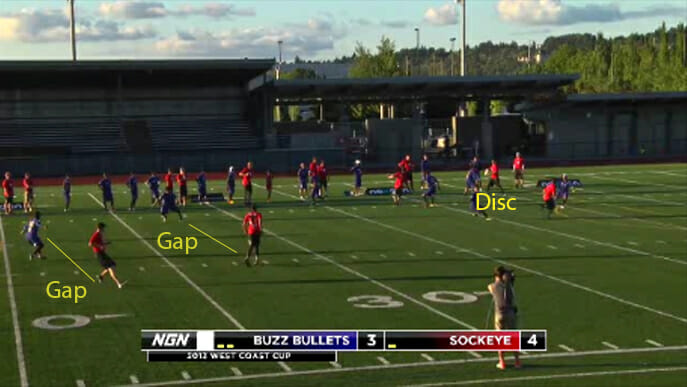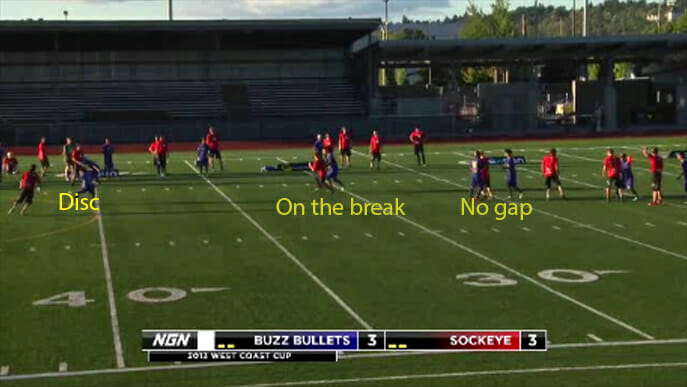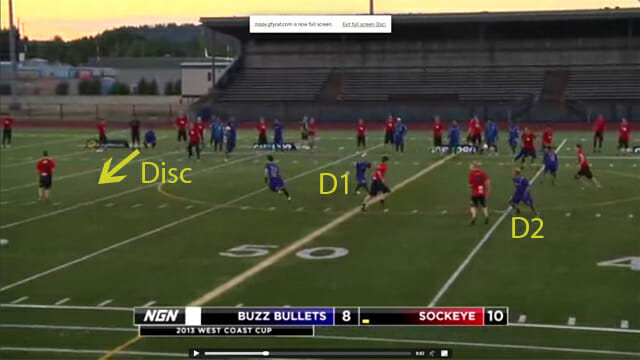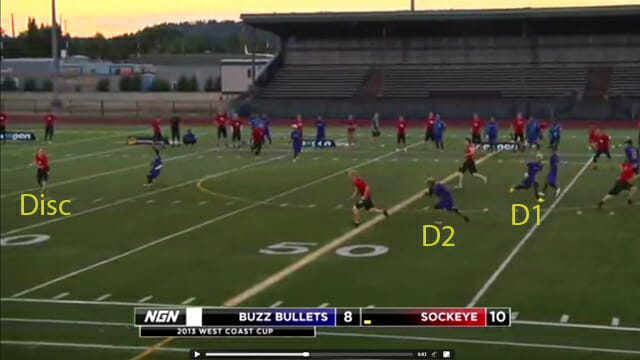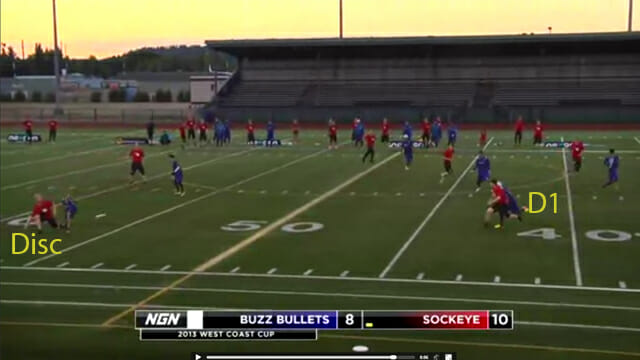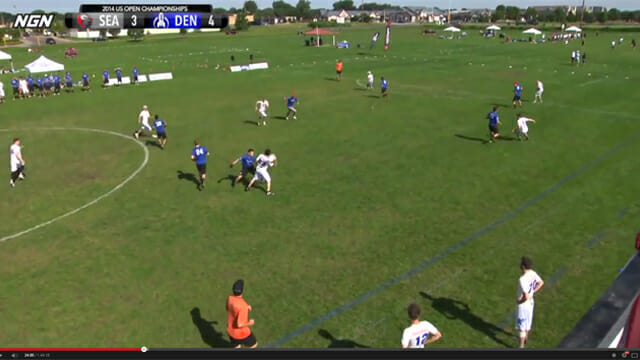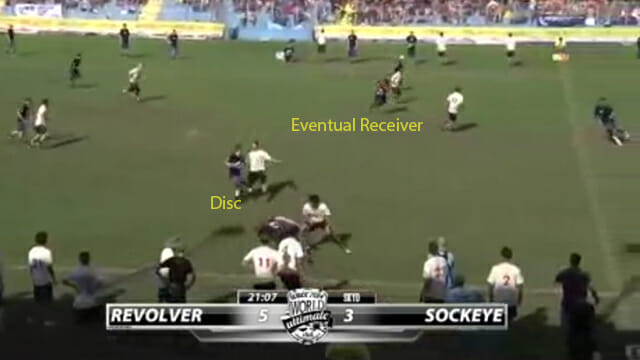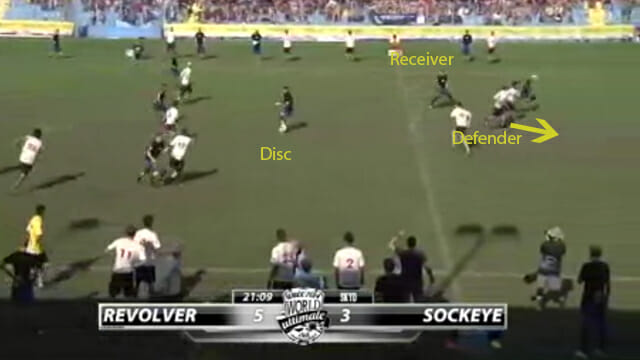There's a lot of reasons to keep the disc moving quickly, but no one does it better than Seattle Sockeye. In this video analysis article, presented by Agility from Five Ultimate, Ultiworld looks at the effects Sockeye's setup has on marks, hucks, disc movement, resets and endzone offense. It's all connected!
August 28, 2014 by David Hogan in Analysis with 19 comments
A year ago I was watching the NexGen livestream of the NexGen-Sockeye game with my roommate. As Sockeye’s offense moved the disc down the field, he looked white-faced. How could a team move the disc that quickly?
As it turns out, the stream had lagged and was trying to catch up, slightly fast forwarding and making everyone look faster. Once we realized that though, it really didn’t change things too much. Sockeye moves the disc quicker than any other team.
Sockeye uses this quick movement to create natural advantages in their favor. Their team-wide skillset has evolved to support this style, allowing them to evolve into a team that relies on chemistry and motion over athleticism and standstill throws. Their style is the complete opposite of Revolver’s, and it’s incredible that such opposing styles exist on the two top teams in the world.
If advanced statistics were able to be applied at an unlimited level to Ultimate, I imagine Sockeye’s offense would be the most efficient one. They invest a minimal amount of risk for a maximal amount of reward, and cause the odds of play to be shifted in their favor.
How Sockeye limits the effectiveness of defensive positioning
The first natural advantage Sockeye’s quick movement creates is to limit the effectiveness of defensive positioning.
With a stationary disc, a downfield defender is able to optimally position himself and not worry about adjusting his positioning through the course of a cut.
Shown here, a disc resting on the force side allows each Buzz Bullets defender (in blue) to open up a cushion in between himself and his respective Sockeye cutter (in red). This allows him to defend cuts that use a lot of horizontal speed without being outrun to the force.
The defenders are able to do this because their matchups are in relative deadspace, a bit behind the mark. Break throws are not viable. A long inside break to the downfield cutters in a trap situation is very difficult, and an around break is impossible with a center handler in the way. Anything thrown to them will sit in the air for long enough that a defender can attempt to recover the cushion.
In contrast, a disc resting on the break side necessitates the Buzz Bullets defenders to play very tight or on the break side of the Sockeye cutters in order to contest a break. A looser gap than this would make breaks far too easy, especially true against Sockeye — where everyone has break throws.
If the disc is swung laterally to the opposite side in either example, the defender would have to adjust his positioning accordingly. The tight defensive positioning used with a breakside disc position would be susceptible to force cuts, as there is no cushion. Similarly, the looser force side positioning would yield easy uncontested breaks if the disc were on the break sideline.
Lateral movement of the disc would naturally open up new passing lanes, similar to how a quarterback in football scrambling outside of the pocket can create new holes in a zone defense. The most intuitive of these situations is when the disc moves from the force to the break.
http://www.gfycat.com/DirtyMeagerBaboon
As we see when they enter the frame, Castine’s defender is in a position that is good for contesting a cut to the trap sideline. As the disc is swung to the break though, this positioning is too deep to defend a throw coming off from the break sideline.
Similarly, movement from the break side to the force side also opens up new passing lanes. We strayed away from this concept on Pitt last fall as we became overly-focused on attacking the break side and often looked off wide-open force side swings and yardage-gaining cuts.
Not only does this motion to the force give yardage, but it will also cause defenders to stop overplaying the break side, opening up break movement in the future.
http://gfycat.com/TornWellgroomedHermitcrab
Both cutters who get the disc in this sequence have their defender beginning the point on the breakside of them, positioned between the thrower and the cutter. As the disc moves middle and force, the defensive positioning is no longer effective and the disc is able to move down the force as the defenders are trying to catch up to the force side.
D2 is beat into the force because of his positioning did not change as the disc was swung. As D1’s cutter is cutting deep, he must choose to spend all of his speed vertically deep instead of on a diagonal path towards the force which would allow him to regain his ideal positioning. This gives the cutter the inside track to cut back underneath with a force advantage.
The defender is never able to regain his positioning and Sockeye is able to gain 15 yards because of this initial swing.
These Buzz Bullets defenders positioned themselves on the break side due to Sockeye’s lethality in moving the disc quickly down the break side. This quick disc movement causes downfield defenders to overpursue to the break side, especially in a vertical stack where a chain of multiple continuation breaks in a row is more dangerous as the break lane is more clearly defined and spaced.
http://gfycat.com/ScentedOpenAmazondolphin
Sockeye is very good at stringing together continuations unhindered. When their offense is using the breakside smoothly, defenses must guard the break cuts tighter and often end up overpursuing, allowing Sockeye’s cutters to beat them back to the force side.
http://gfycat.com/CompassionateHonorableEarthworm
The cutter moves towards the break for a continuation. When the break is not thrown, he makes an S cut back to the force. The defender overplays the break cut and gives Sockeye an easy goal.
Especially in a vertical stack, this quick force-to-break movement is so difficult to defend because the defender must adjust the size of his gap during the cut itself. Let’s say in this previous example the disc began on the force sideline rather than the middle. While on the force sideline, the Clapham defender would have given himself a few yard gap. While the disc is being swung to the break, that gap is now too large.
So the defender must work to shrink the gap. By the time he realizes this, the Sockeye cutter is already moving break. The Clapham defender can choose to try to shrink this gap by outrunning the Sockeye cutter. If he does so, he’s very vulnerable for an S cut back to the force. If he doesn’t try to outrun him, the gap is large enough for the break throw to be thrown into a large window.
Sockeye regularly puts defenders in these tough positions where they can either ineffectively defend multiple options, or can sell out to prevent one option but are then left vulnerable to a different attack.
When the danger of quick continuation breaks is absent, the defensive equation is simplified and downfield defenders are able to hold their force positioning and force throwers to throw into tighter windows. We can see this contrast in a horizontal stack, where the breakside handler and cutters are often cutting off any chance of similar continuation breaks.
http://gfycat.com/LankyInsidiousIndianpalmsquirrel
Because Mickle remains on the force side, the thrower must throw a tougher IO flick huck rather than a force side shot like in the prior clip, which gives Mickle a chance at a defensive block. While Mickle’s cutter would be able to receive an inside flick due to his positioning, Mickle knows there would not be a ready string of continuations before he’s able to set the mark, and wisely positions to take away the most dangerous option.
Sockeye is highly skilled at reading errors or openings in defensive positioning and taking advantage of it as a unit with motion. When a defender overplays their positioning, Sockeye is quick to make them pay. In instances where Sockeye does not even recognize their advantage, their dedication to quick motion will allow these advantages to naturally reveal themselves. This is why moving the disc so often is such a great default strategy – it doesn’t require the players to think several moves ahead when they’re throwing. Just keep moving the disc and things will open up.
http://gfycat.com/BlackVioletGuillemot
The Revolver defender is in a good position to defend the force, where the disc is resting. But he is slightly too loose, and Sockeye responds with immediate break motion that hits that open player quickly, giving the Revolver defender no time to catch up. The initial thrower does not realize the Revolver defender is so loose. He’s just trying to move the disc quickly, and the disc rather naturally finds its way to the open player on the break.
This image shows 5 of the 6 off-disc Bravo defenders positioned correctly. Only the handler cover is playing too loose, yet the result is a quick goal.
http://gfycat.com/ScentedOpenAmazondolphin
Similarly, a defender positions himself on the break to place himself between the cutter and the disc, Sockeye will just look to strike back to the open force side if they’re able.
http://gfycat.com/OldfashionedIncompleteBlackfish
It is for these reasons Sockeye is one of the worst teams to poach against. So many players are active and the disc moves so often that the equation for a defender changes very quickly, and their poach becomes a liability almost immediately.
How Sockeye Uses Power Positions to Limit Mark Effectiveness
Sockeye excels at creating and using power positions.
We’ll define a power position as receiving the disc in motion with a trailing, unset mark. Power positions can come upline, towards the break, or into the force. For that 1-2 second window before the mark can set, the thrower is at a huge advantage.
In contrast, a good, set mark is able to put pressure on multiple throwing options. And a stagnant disc gives the mark time to set. As the stall count rises past 2, the mark does not need to worry too much about hucks, knowing that it’s now a lower percentage throw. This allows the mark to key in on preventing reset throws, knowing that is the most dangerous throw.
http://gfycat.com/CluelessCleverElkhound
The mark flashes the force lane for a second, concerned with a dangerous deep continuation. Caldwell is unable to find a quick dish off the sideline to exploit this opening, and the mark clamps down. Once the mark has set, he is disciplined in not biting on force side fakes, and is just concerned with contesting inside breaks and preventing around breaks. This results in a (somewhat suspiciously quick) stall.
Sockeye is much more successful throwing hucks from a power position than from a standstill. The mark during a power position can really only choose to affect one throw, and must sell out to do so. This leaves other throws open.
Sockeye wants to move the disc within this small time frame, maximizing the number of power positions they have during a game. This minimizes the amount of effect the mark has on their offense.
In this first example, the cutter is moving towards the break side with a properly-positioned force-side defender. The mark must sell out to contain the easy around backhand break throw, leaving the inside flick uncontested.
http://gfycat.com/WillingWelcomeDutchsmoushond
This same dilemma repeats itself during force and upline cuts, where the mark has to decide whether or not to give the thrower an unmarked huck at the expense of yielding a free reset off the trap sideline. Because Sockeye is much more effective hucking from power positions, many marks in this situation choose to flash force and blow up the huck, yielding a quick reset.
Sockeye wants to get the disc off of the force sideline before a mark is able to set a heavy trapping mark. This has influenced how they set up their force-side reset system.
http://gfycat.com/SlowDaringIrishwaterspaniel
If the mark has set, Sockeye will deliberately pivot with the intention to get the mark to bite on an upfield throw. Watch any number of Sockeye games and you’ll see the most deliberate and robotic downfield fakes of any team in an effort to give themselves an easier reset back to the middle of the field.
http://gfycat.com/QuaintAbleIrishredandwhitesetter
Because the goal of the reset thrower is to get the throw off as quickly as possible, the reset is thrower-led. This means the handler has to be ready to receive the disc during that split second the mark is jumping force. You can see the chop steps from the dump in the clip above as he recognizes the mark is biting on a fake, anticipating that this might be the moment when the around throw goes off; indeed, it is.
Sockeye wants to throw their resets directly to their dumps rather than leading them out into space towards the break. This causes the shape of their cuts to be more vertical than diagonal.
http://gfycat.com/OnlyHardtofindHammerkop
There is a trade-off here. Because the dump is not moving towards the break, it is very easy for his mark to set himself after the reset pass, meaning the centering pass does not result in a power position. The goal of the reset is to reset the disc, and whether or not the reset makes it easier to move the disc break is not a factor.
This is contrasted with a reset thrower who allows the dump’s cut to take the lead. The trade-off is visible here. The cut takes longer and the reset thrower’s mark is able to set, resulting in a more difficult throw. But the reward is an easier break side continuation after the reset is completed as the cutter is moving towards the break side, resulting in a trailing mark.
http://gfycat.com/GranularDeterminedAidi
Sockeye’s reset from the trap sideline requires both chemistry and commitment. When an offense is unclear whether resets are thrower-led or dump-led, miscommunications like this occur and cause turnovers.
http://gfycat.com/JadedDependableDikdik
Oakland had this early issue last fall, and our decision to commit to a system (with us it was dump-led resets) eliminated these unforced errors.
While Sockeye is one of the best break-throwing teams in the world, they also excel at creating power positions to the break without actually having to break the mark in the first place. By investing very little risk with safer throws, they are able to create massive rewards with free break throws, as the mark is trailing. They do this in three ways.
With a centered disc, Sockeye runs force-side players across the field to the break. This will only come from cutters in a horizontal or side stack, but can also come from handlers in any formation.
http://gfycat.com/ViciousDelightfulAsiantrumpetfish
The thrower barely breaks the mark, if at all. The flick goes straight downfield. But the result is still an unmarked continuation break throw. While this throw requires throwing into a smaller window, that’s something Sockeye excels at.
Sockeye also uses a lot of pop outs towards the break side to give their cutters unmarked breaks.
http://gfycat.com/BlackVioletGuillemot
Again, Sockeye turns a relatively easy throw – this time a 2-yard backhand – into an uncontested break. The pop out is a great choice in this situation as Rehder is barely moving and his defender should be able to put the mark on quickly. As Karlinsky is in a full sprint, his defender has a lot more work to do to catch up and apply an effective mark.
The third way Sockeye creates these easy power positions is how they set up their resets on the break side. Here, Sockeye uses the same dump setup that Pitt uses that was touched upon in a previous article. In this set up, the center handler sets up a few yards behind the disc, rather than even. Not only does this keep the break space open, but this set up also gives that dump two dangerous cuts to make.
http://gfycat.com/WarmheartedFrighteningKouprey
With the flick force, Gehret simply cuts behind the disc and throws a backhand break without any mark. If that cut were taken away, his other option is a pop out to the force, giving him a quick unmarked throw there as well, as Pitt demonstrates here.
http://gfycat.com/CautiousIdenticalGossamerwingedbutterfly
Either option would give Gehret an unmarked break throw as a result of an uncontested 5 yard backhand.
How Sockeye’s quick movement limits help-defense
A stagnant disc allows inactive defenders to key in on one cutter or throwing lane and provide help defense. The defender no longer needs to worry about readjusting his positioning as the disc moves, and can instead focus on analyzing the play and looking for opportunities to provide help defense.
With a nonmoving disc, it’s very clear to a defender which cuts are viable options. Because the disc is stationary on the break side, Freechild knows the only space his cutter can get the disc is either deep or into the occupied break space, as a slew of players are clogging force side cuts as well. This allows him to freely sit deep and keep his head up to provide help defense and contest the huck.
If the disc were swung to the force at that point, Freechild would need to adjust his positioning to guard his cutter making a force cut rather than allow himself to remain in a deep help position. Because the disc remains stagnant, Freechild can instead read the thrower’s eyes, see his vision isn’t changing, and know that a huck is imminent.
Lateral disc movement causes players who were not able to get the disc before be the best option for a cut soon thereafter. It also quickly punishes a player looking to provide help defense.
The eventual receiver is not in a good position to directly receive the disc, and his defender begins to look downfield for opportunities to help, as he is given himself a force-side cushion.
The defender takes about a half-step deep to chase the deep cutter at the same time the disc has been swung to the middle. His cutter is now completely uncovered and is immediately hit for a break. If the defender had been watching the disc and/or his cutter, he would have known to play tighter as the disc moved break and his cutter was a more viable option. But since he was watching downfield, he was unable to anticipate this motion and recover in time. Disc movement has changed the passing lane, making a previously dead cutter become the best option.
Sockeye’s small-space throws
Much has been said of Sockeye’s offseason Goaltimate affecting their style of play. It’s particularly given them the best small-space throws in Ultimate, which they use to create very dangerous power positions. Sockeye is especially willing to throw into small spaces when the reward is great: upline to the break side, and near the end zone.
Revisiting Sockeye’s breakside dump system, we find one method of attack they hit with particular consistency and effect. This is an upline cut towards the break side.
http://gfycat.com/UnluckyOpenAurochs
This is a medium-risk high-reward throw, and is why many players have begun developing off-handed backhands. Sockeye has those throws, but their IO flicks are also incredibly reliable. Their choice of throw will usually depend on where the mark is positioning himself, or whether or not a downfield defender could make a play on a leading backhand. In that example, Revolver had a defender in the vicinity that necessitated the choice of an IO flick.
http://gfycat.com/DiligentChubbyAfricancivet
As we’ve seen in the two previous clips, these power positions are the most dangerous because the mark is completely out of the picture, allowing the thrower to have wide-open looks deep, break, and force. This is especially true when a leading backhand is the throw of choice.
http://gfycat.com/CautiousIdenticalGossamerwingedbutterfly
The mark is trailing vertically, as opposed to horizontally as we would see during a break cut. We can contrast that visually with a typical power position to the break.
http://gfycat.com/FairUnfinishedCaracal
Here, the thrower wants to throw a quick huck to the break side deep cutter. But because that cutter is on the break sideline, the open backhand would be an ill-advised throw as it would have to travel over the cutter’s head through a narrow lane. The thrower correctly identifies this and attempts a flick huck which would have more space, but throws it directly into his mark.
A power position moving to the break briefly takes away the ability to throw to the force side. A power position moving upline has a smaller period of open time, but has the entire field to throw to.
Sockeye’s end zone offense
A year and a half ago, Ultiworld ran an article highlighting NexGen’s end zone offense, and how their “jam-it-in” system actually proved to be more effective than the conventional dump-swing system that most teams employ.
http://gfycat.com/AcademicTerribleAnophelesmosquito
Sockeye’s preference to move the disc quickly actually disappears near the end zone: they often prefer to keep the disc stationary whether it’s on the force or break side. Instead of disc movement, it’s, their quick cutter motion and excellence in throwing into small spaces that gets them goals.
http://gfycat.com/GrayRespectfulAardwolf
It is an oversimplification, but around the end zone there is force space, break space, and upline space, outside of the stack. Sockeye will usually have at least two different players attacking the upline space via motion at the same time.
They can do this because their small-space throwing ability makes it difficult for them to actually clog a space. Let’s say most teams are comfortable giving a player about 4 yards of space around him as his to own. This distance may not be accurate, but it will let us understand the point. Sockeye shrinks that personal space into a 2 yard area, meaning players can be a lot more aggressive cutting near other players because they’re not hindering the other’s ability to get the disc.
http://gfycat.com/LeadingPettyCardinal
We can see the beauty and purpose of their offense. There are consistently two players each vying for the upline space at the same time, while the front of their stack fills in to the center handler position after the upline cutter clears. Other members of their stack are actively looking to get involved in the play, regardless of where in the stack they are. It’s amazing that there’s this much effective movement when the disc is trapped near the end zone.
This frenetic cutter motion gives them offensive advantages similar to the ones gained from a moving disc. When clogging is barely an issue, it’s difficult to even have too much cutting. The more cutters moving, the less effective the defense can be.
Why is this cutter motion so effective? Cutter motion prevents and clears out poaching. The typical dump-swing end zone offense is very predictable, and high-level defenses can set up poaches and switches on the fly to disrupt it. Poaches rely on inactive players, which Sockeye rarely has when almost everyone is moving.
Cutter motion prevents a defender from becoming set in his positioning. This makes it difficult for a defender to even look for poaching or switching opportunities. It also means that over the course of the cut, the defender will fall further away from his ideal positioning, and must either accept that or overpursue to regain it.
Cutter motion clears space. If a defense has set up a switch, the motion will usually clear that switch out and force the defense to revert to straight man defense. It also allows typically tertiary options like middle-of-the-stack cutters to consistently be a dangerous threat.
We can see all three of these advantages in play in this one goal.
http://gfycat.com/DefensiveSpiritedChital
You’ll hear a lot of people watch that offense and say “Sockeye needs to clean things up” and things of that nature. Don’t listen to them. There isn’t clogging. No one’s cutting each other off. A beautiful thing about a vertical stack is how there are distinct levels, and while there are three players cutting force simultaneously here, they are stacked as to allow Harkness (#9) to have been hit with a swing if possible.
What this movement does so well is open things up and allow Sockeye to react to how the defense is playing. It allows them to be the ones dictating play. As the swing comes across, three Sockeye players all move force. Seeing this, they all sprint to clear into a separate dangerous position – Simon (#10) and Harkness move into their respective proper dump positioning, and the downfield cutter slashes into the break.
This break cut clears out a lot of space, and is akin to common pull plays that begin with players running decoy cuts to clear space. As another Rhino defender tries to help out on the break cut, his cutter is left wide open for an easy score. This constant motion demands man defense. Sockeye cutters are cutting and clearing so often, giving the defense little way of knowing which one they’re doing at the time.
Sockeye is very good at quickly scanning a crowded area and understanding what their best option as a cutter is while moving. You will rarely see a Sockeye cutter cut off another cutter and force him to stop his cut. The “cut off” cutter will move quickly to another space, and will often look to jump right back into the space they first wanted once it becomes available.
http://gfycat.com/DifferentGrandioseGelding
When it’s all put together, Sockeye’s offense allows them to create maximum reward with little risk . Their quick disc movement limits or removes key defensive advantages. Their “chaotic” cutting results from their ability to throw into tighter windows than any other team and allows them to move the disc more often.
When their masterful end zone offense is applied to a full field, this larger space encourages them to both move the disc quickly and have a lot of active cutters. This combination gives Sockeye’s offense a unique look and feel that consistently puts defenders on their heels and in no-win situations.
